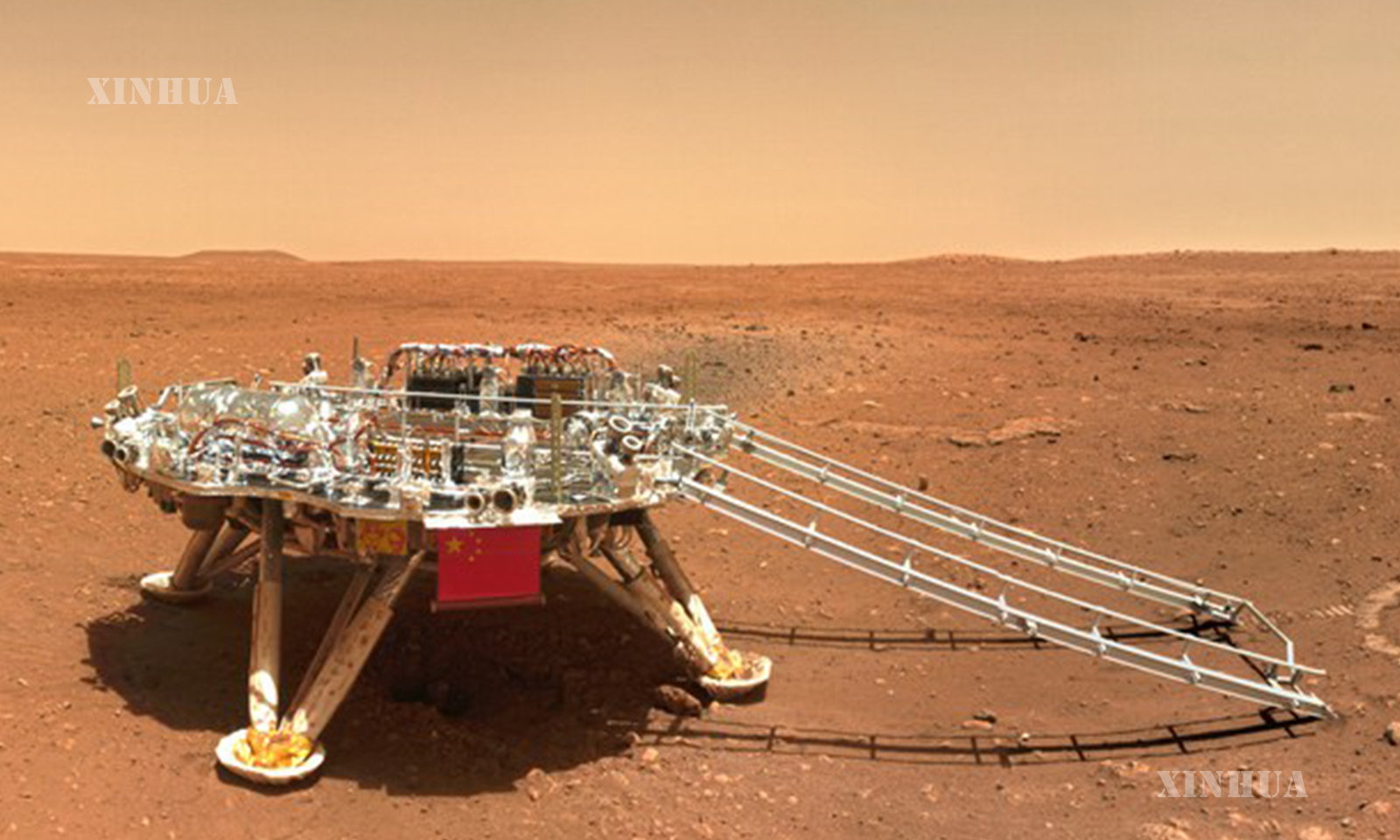Science & Technology
တရုတ်နိုင်ငံက အနာဂတ် အာကာသစူးစမ်းလေ့လာရေးအတွက် အစီအစဉ်များ ချမှတ်ထား

ပေကျင်း၊ ဇွန် ၁၃ ရက် (ဆင်ဟွာ)
တရုတ်နိုင်ငံသည် ဂြိုဟ်သိမ်ဂြိုဟ်မွှားများနှင့် Jovian စနစ်၊ အင်္ဂါဂြိုဟ်မှ နမူနာများ စုဆောင်ခြင်းနှင့် လ၏ဝင်ရိုးစွန်းဒေသ စူးစမ်းလေ့လာရေး အပါအဝင် အာကာသအစီအစဉ်၏ အနာဂတ်ဖွံ့ဖြိုးတိုးတက်မှုအတွက် အစီအစဉ်များ ချမှတ်ဆောင်ရွက်လျက်ရှိကြောင်း တရုတ် အမျိုးသား အာကာသစီမံခန့်ခွဲမှုဦးစီးဌာန (CNSA) က ဇွန် ၁၂ ရက်၌ ပြောကြားခဲ့သည်။ကမ္ဘာအနီး ဂြိုဟ်သိမ်ဂြိုဟ်မွှားမှ နမူနာများ စုဆောင်းရန်နှင့် ကြယ်တံခွန်ကို လုပ်ငန်းစဉ်တစ်ခုတည်းဖြင့် စူးစမ်းလေ့လာရန် အာကာသယာဉ်တစ်စင်း လွှတ်တင်ရန် တရုတ်နိုင်ငံ၏ ၂၀၂၅ ခုနှစ် အစီအစဉ်များအကြောင်းကို ပေကျင်းမြို့တွင် ပြုလုပ်သော သတင်းစာရှင်းလင်းပွဲ၌ CNSA ၏ ပြောရေးဆိုခွင့်ရှိသူ Xu Hongliang က ပြောခဲ့သည်။
တရုတ်နိုင်ငံသည် အင်္ဂါဂြိုဟ်မှ နမူနာပြန်လည်သယ်ဆောင်ရေးမစ်ရှင်နှင့် Jovian စနစ် စူးစမ်းလေ့လာရေးမစ်ရှင်ကို ၂၀၃၀ ပြည့်နှစ်ခန့်တွင် လွှတ်တင်ရန် စီစဉ်ထားကြောင်း Xu က ဆိုသည်။
တရုတ်နိုင်ငံသည် လာမည့်ငါးနှစ်အတွင်း သဘာဝပတ်ဝန်းကျင်နှင့် အရင်းအမြစ်များ စူးစမ်းလေ့လာရေးနှင့် လ၏ဝင်ရိုးစွန်းဒေသမှ နမူနာများ စုဆောင်နိုင်ရေးအတွက် Chang’e-6 နှင့် Chang’e-7 လကမ္ဘာသွားအာကာသယာဉ်များ လွှတ်တင်ရန်လည်း စီစဉ်ထားကြောင်း Xu က ဆိုသည်။
၂၀၂၂ ခုနှစ် နှစ်ကုန်မတိုင်မီ တရုတ်နိုင်ငံ၏ အာကာသစခန်းတည်ဆောက်ရေး ပြီးစီးနိုင်မည်ဖြစ်ကြောင်း၊ ယင်းစခန်းတွင် အာကာသပညာရှင်များအနေဖြင့် သိပ္ပံပညာရပ်ဆိုင်ရာ လက်တွေ့သုတေသနပြုမှုများအား ဆောင်ရွက်ရန် အချိန်ကြာကြာ နေထိုင်နိုင်မည်ဟု Xu က ပြောခဲ့သည်။
“ကျွန်တော်တို့အနေနဲ့ နည်းပညာအားဖြင့် နားလည်သဘောပေါက်သော၊ ငွေကြေးအရ သင့်တင်လျောက်ပတ်သော၊ သိပ္ပံနည်းကျပံ့ပိုးမှုရှိသော စည်းမျဉ်းအရ အာကာသသိပ္ပံ၊ အာကာသနည်းပညာနဲ့ အာကာသ application တွေကို ညှိနှိုင်းဆောင်ရွက်သွားသင့်ပါတယ်” ဟူ Xu က ပြောကြားခဲ့သည်။
ခက်ခဲစွာလွှတ်တင်ရသော ယာဉ်များ၊ ပြန်လည်အသုံးပြုနိုင်သော အာကာသသယ်ယူပို့ဆောင်ရေးစနစ်များနှင့် ဂြိုဟ်တုအင်တာနက် ဖွံ့ဖြိုးတိုးတက်မှုသည် အနာဂတ် ဖွံ့ဖြိုးတိုးတက်မှုအစီအစဉ်များ၏ ဦးတည်ချက်လည်း ဖြစ်ကြောင်း Xu ၏ ပြောကြားချက်အရ သိရသည်။
CNSA က တရုတ်နိုင်ငံ၏ ပထမဆုံး အင်္ဂါဂြိုဟ်ပေါ်သွားယာဉ် ကျူးလုံ (Zhurong) မှ ရိုက်ကူးထားသော ဓာတ်ပုံအသစ်များကို ထုတ်ပြန်ခဲ့ပြီး တရုတ်နိုင်ငံ၏ ပထမဆုံး အင်္ဂါဂြိုဟ် စူးစမ်းလေ့လာရေးခရီးစဉ်၏ ပြီးပြည့်စုံသော အောင်မြင်မှုကို ဖော်ပြခြင်းလည်း ဖြစ်သည်။
တရုတ်နိုင်ငံသည် ထျန်းဝန်-၁ (Tianwen-1) မစ်ရှင်တွင် ထိုးဖောက်ကျော်လွှားမှုအသစ်ကိုလည်း မြင်တွေ့နိုင်ကြောင်း၊ အဆိုပါယာဉ်သည် ပထမဆုံးအကြိမ်အတွက် ဂြိုဟ်အချင်းချင်း ပျံသန်းမှု၊ အခြားကမ္ဘာဂြိုဟ်ပေါ်တွင် ညင်သာစွာဆင်းသက်ခြင်းနှင့် သွားလာခြင်းများကို အောင်မြင်စွာ လုပ်ဆောင်နိုင်ခဲ့ကြောင်း Xu က ပြောသည်။
အင်္ဂါဂြိုဟ်ပေါ်သို့ ဂြိုဟ်ပတ်လမ်းကြောင်းပတ်ခြင်း၊ ဂြိုဟ်ပေါ်ဆင်းသက်ခြင်းနှင့် ဂြိုဟ်ပေါ်သွားလာခြင်းကို လုပ်ငန်းစဉ်တစ်ခုတည်းတွင် ပြီးစီးခြင်းသည် တရုတ်နိုင်ငံက အင်္ဂါဂြိုဟ်စူးစမ်းလေ့လာရေး၌ ကမ္ဘာ့ရှေ့တန်းသို့ ရောက်ရှိလာခြင်းဖြစ်ကြောင်း Xu က ဆိုသည်။
ယင်းသို့ ဆောင်ရွက်ခြင်းသည် တရုတ်နိုင်ငံအနေဖြင့် အကွာအဝေး ကီလိုမီတာ သန်း ၄၀၀ အတွင်း စောင့်ကြည့်ခြင်းနှင့် ဆက်သွယ်ရေးလုပ်ငန်းများ ဆောင်ရွက်လျက်ပြီး အင်္ဂါဂြိုဟ်ပေါ်မှု သိပ္ပံပညာရပ်ဆိုင်ရာ အချက်အလက်များ ရရှိခြင်းသည် ပထမဆုံးအကြိမ်ဖြစ်ကြောင်း ၎င်းက မှတ်ချက်ပြုခဲ့သည်။ (Xinhua)
——————————————
(English Version)
China making plans for future space exploration: official
BEIJING, June 12 (Xinhua) — China is making plans for the future development of its space program, including exploring asteroids and the Jovian system, collecting samples from Mars and exploring the polar region of the moon, said an official from the China National Space Administration (CNSA) on Saturday.
Xu Hongliang, a spokesperson of the CNSA, said at a press conference held in Beijing that about the year 2025 China plans to launch a probe to collect samples from a near-Earth asteroid and explore a comet in one mission.
China plans to launch a Mars sample-return mission and a Jovian system exploration mission sometime about 2030, Xu said.
In addition, China plans to launch the Chang’e-6 and Chang’e-7 lunar probes in the coming five years to explore the environment and resources and collect samples from the polar region of the moon, Xu said.
By the end of 2022, China will have completed the construction of its space station, in which astronauts can stay for prolonged periods to carry out scientific experiments, Xu said.
“We should coordinate space science, space technology and space applications, in accordance with the principle of being technically realizable, financially affordable and scientifically contributive,” said Xu.
The development of heavy-lift launch vehicles, reusable space transportation systems and satellite internet will also be the focus of future development plans, according to Xu.
The CNSA released new images taken by the country’s first Mars rover Zhurong on Friday, signifying the complete success of China’s first Mars exploration mission.
Xu said that China has seen new breakthroughs in the country’s Tianwen-1 mission. The probe has, for the first time, successfully completed the interplanetary flight, soft-landing and roving on an extraterrestrial planet.
The completion of the orbiting, landing and roving on the red planet in one mission indicates that the country has come to the forefront of the world in Mars exploration, Xu said.
He also noted that this is the first time that the country has carried out monitoring and communication activities over a distance of 400 million km and obtained first-hand scientific data on Mars. ■
The China National Space Administration released new images on June 11, 2021 taken by the country’s first Mars rover Zhurong. The photo shows China’s national flag unfurled from the glistening landing platform on the red planet. (Photo provided to Xinhua)






